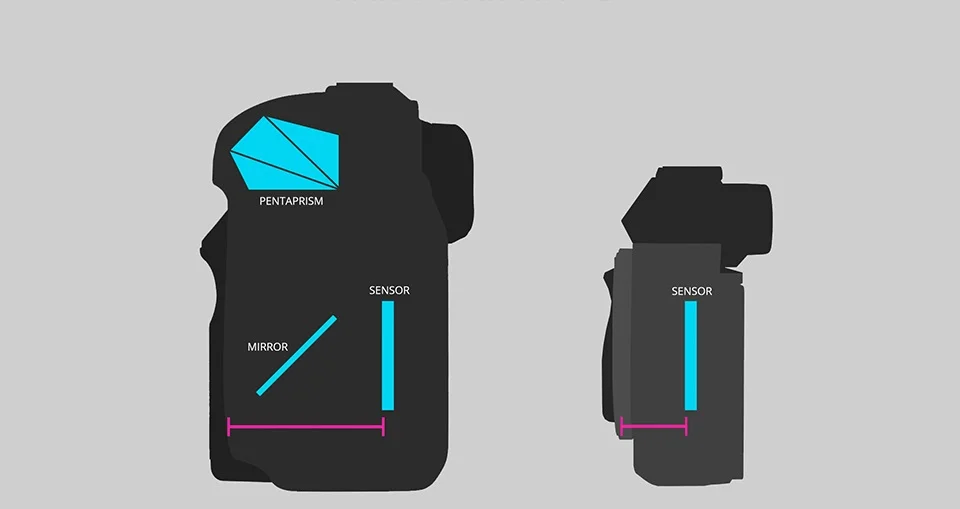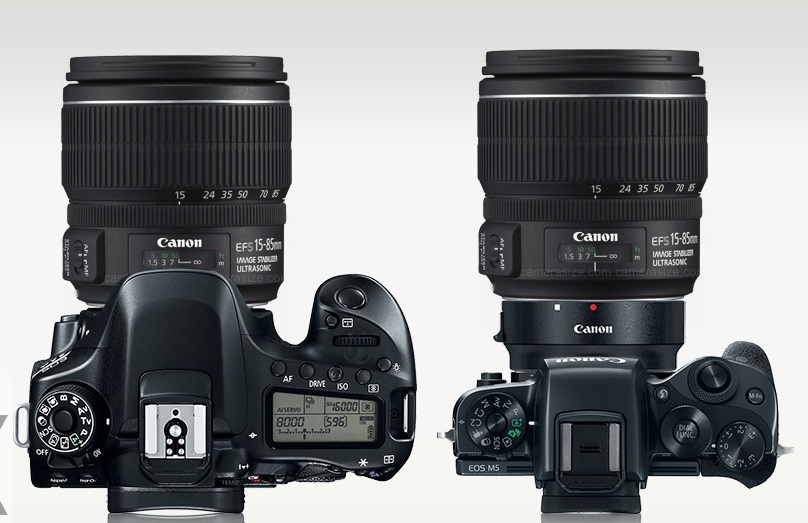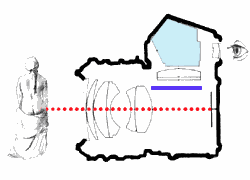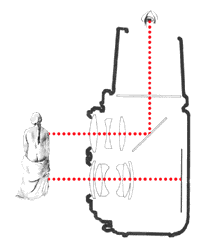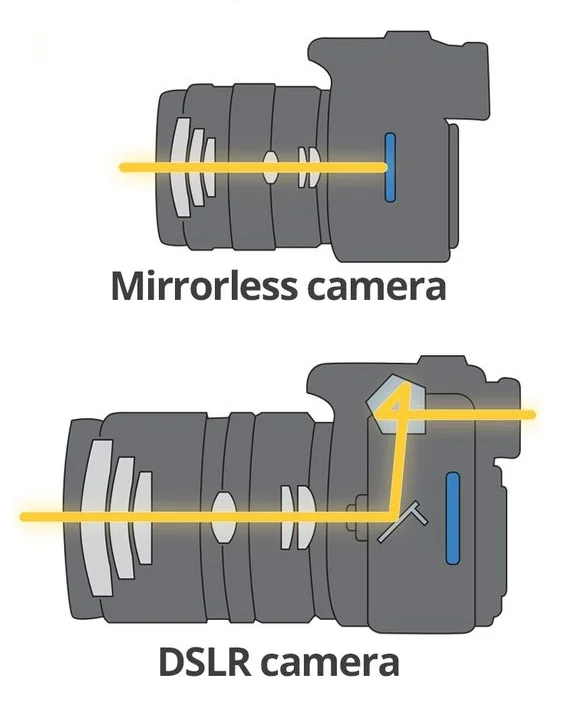DSLR VS MIRRORLESS [So you wanna buy a mirrorless camera (part 2)]
Now I answer the question “Which is better” by giving the answer “ That is dependent on what your preference is and your workflow”.
When discussing these cameras a few years ago I could confidently say “Hey, let’s do a blog title “Which is better”, and confidently come up with a winner. What a difference a handful of years make… Now I answer the question “Which is better” by giving the answer “ That is dependent on what your preference is and your workflow”. I’ll go in depth on the minutia for my reasoning but for those that want a TL;DR I’ll break it down like this.
Remove the pentaprism and the mirror from the DSLR; you start to streamline to a smaller size and a lighter weight.
AMATEUR
~ [looking to understand or get into photography]
BUY 35mm FILM CAMERA
~ [don’t wanna do film] dSLR entry level
~ [younger/older photographer] mirrorlessPROSUMER ~ [vacationer] mirrorless
~ [vlogger/blogger] mirrorless
~ [younger / older shooter] dSLRPROFESSIONAL ~ [self employed photographer] dSLR
So why would you want a mirrorless camera? When considering how long you’d be holding on to the camera shooting, and with certain heavier lenses, the much needed break in size and weight is a godsend. I would recommend going mirrorless if you are going “lighter” on photography gear. Perfect for the upcoming vacation/ convention seasons, you’ll travel lighter and won’t sacrifice the image quality if you did think of going mirrorless. Also, the younger and older photographers out there should think of going mirrorless as the size and weight won’t tire you out physically when going out shooting. To not overstate the weight and size a vlogger or blogger will struggle less with a nice light lens and a mirrorless camera on a mini tripod like the Joby GorillaPod. Lastly I wanna touch on this cautionary warning. A dSLR has a mirror and a shutter screen that blocks the sensor and acts as a protector from any dust or damage to the sensor, with the mirrorless camera…you don’t have that protection. Essentially any dust, dirt, scratches, or splashes that would get into a mirrorless camera would effect the sensor, and any damage to the sensor could very well ruin the camera. I don’t want to deter you from getting what technologically speaking is a “as-good or better than dSLR” camera, and extreme instances of carelessness would be the only cause damage that bad.
Your back and camera bag will thank you for switching or choosing mirrorless cameras as your photography choice.
The difference to (left) Canon 80D with lens and (right) Canon M5 w/ adapter and same lens is non-existent.
Now, on the flip side… Let’s say you are deterred by the sensor being exposed when changing lenses and what have you. Let’s also say that you’ve been using film SLRs of a certain brand that work with dSLRs without the need for adapters (more on this later). Let’s also say that comparatively you want a longer battery life (500+ shots on average), the weight difference isn’t important (on average the weight difference is 2-3lbs), and price is of some concern. Well then, welcome to dSLRs where almost 30 years of digital technology have been developed inside SLR bodies. The glass in almost every instance has a 30+ year timeline which is usable with AF (auto focus) on dSLR cameras today, without adapters. Nothing against mirrorless cameras, but the added weight for the ability to use legacy or vintage cameras almost mitigates the size and weight advantage mirrorless cameras have. Lastly there’s every serious and professional photographer’s nightmare: Disk Error & Data Corruption. The mirrorless option has a few answers to this issue, offering dual SD or CF slots, but dual slots is almost a standard on profession dSLRS. You the reader must be asking “with all these advantages, why even go mirrorless”. Here’s where, beyond the facts given, my opinion comes in.
FINAL THOUGHTS
Canon is the company I chose. I have few reservations after choosing the brand after learning photography on my old Canon AE-1 camera. I was familiar with Canon’s product lingo so I wasn’t lost in trying to determine if an EF-S lens would work on a specific body, or vice versa. Over the years I’ve seen Canon really innovate their AF game while losing the fight to certain Nikon cameras. When mirrorless came out swinging I paid attention to Sony (though Fujifilm was not taken for granted) and the a7 series of mirrorless cameras. Their color science and image quality was amazing. I’m on the precipice of, adapting another brand of cameras, and with my trip coming up I just may, but currently mirrorless cameras of any brand just isn’t justified YET for me….is it for you?
Next week, if you are going mirrorless I’ll have a list of cameras both current and a generation or two behind that are real workhorses and should be considered if you are buying a mirrorless camera. The following week will be a buyers guide for dSLR cameras, to give each “type” their own spotlight. I will preface two thing each week as I wrap up now.
GET GLASS FIRST! I cannot stress getting high quality lenses in your brand’s wheelhouse before the camera. Pick up a cheap body or an older body, or snag a deal…but get GLASS first!
The gear does not make the photographer. If you have THE camera and lens to end all cameras and lenses it does nothing if you can’t understand proper exposure and composition. The gear can “cover up” shortcomings but peers will notice and you’ll be a better photographer starting small.
None of what I write, show, or vlog will matter a damn if you…yes you, do not break from the internet and go out shooting and experimenting yourself. You will be a tenfold better photographer by learning from your mistakes and stumbling upon happy accidents before learning from me or anybody else.
So go snap pics and be active, always learning from each shot and less concerned with gear; just concerned that the next photograph you make will be better than the last. Cheers!
So you wanna buy a mirrorless camera (part 1)
I’ll let you decide in this series. We will take a look at first what this technology is, compare and contrast with dSLR (digital Single Lens Reflex) cameras, and finally give examples of both brands and certain makes of cameras to look for if you yourself are going to make the plunge. So let’s answer the first question:
What is a mirrorless camera?
The year is 2012 and a few photographer colleagues are asking me what I think about mirrorless cameras, to which I say “A flash in the pan, mark my words and don’t spend anymore money than you have on them. Focus on glass!” I would end up eating my words on half that statement, owning up to the fact that this May, for a vacation with my wife, I’ll be packing a mirrorless camera for the first time. But how did I get to this point that I’m eating crow? Was it the constant bombardment of photographer bloggers and YouTubers showing off their cool new gear, or rather…was it time “going mirrorless” should be looked at as an option having lasted as long as they have with huge leaps in advancement from what they were…I’ll let you decide in this series. We will take a look at first what this technology is, compare and contrast with dSLR (digital Single Lens Reflex) cameras, and finally give examples of both brands and certain makes of cameras to look for if you yourself are going to make the plunge. So let’s answer the first question:
What is a mirrorless camera?
To answer what it is, I gotta explain what it isn’t. To explain what it isn’t I have to go back, back, back in time to show how it evolved into the camera it became. Cameras for the longest time had no way of showing you want you were shooting. you would aim the camera at the subject and unless you planned out the shot and where to frame it there was a good chance the subject would be out of focus or out of where you had composed the subject. Cameras with viewfinders helped (if you knew how to combat parallax error) but would wouldn’t show what the lens saw and put on film, until Twin-Lens Reflex cameras.
Twin-Lens Reflex as the name would suggest was a camera with two lenses. one game you a better approximation of where your subject was and how it would show up on film with again roughly the same field of view as what the film would record. Through the top lens and bounced off a mirror (I think you know where this is going) within the camera the photographer could see the subject. This would be the first leap forward in seeing what the end product would be before taking the shot, allowing recomposing the subject and focusing without botching the photograph. Life was good, and then the new upstart SLR cameras came in to change the game.
SLR, as stated previously, stands for Single Lens Reflex. This new innovation would be the standard for how the contemporary cameras would function into the digital age. The mirror pulls double duty offering a TTL (through the lens) view to compose, and when ready flipping up to imprint the subject on film or sensor depending on the technology.
Glossing over the history you get the idea of where the next stage in camera technology would move to. In the name mirrorless cameras remove the flip up mirror to offer a more lens to sensor connection..Your viewfinder is an electric viewfinder (viewable only when the camera has power) giving you exactly what the sensor will pick up and read. Certain functions like AF (auto focus) and exposure were bounced around through the mirror previously, but now the direct lens to sensor offers a more condensed A - B communication connection. There is no inherit advantage to this over the dSLR, in fact when the technology of mirrorless first came out dSLRs were the better choice for focusing. Currently however certain flagship dSLRs are getting a run for their money from many competent mirrorless cameras. I suppose to compare and contrast one needs to ask..
Which is better dSLR or mirrorless ?
Which I’ll handily answer next week in part 2. Thanks for being so patient the past year and change, but I plan on being more consistent and will have my work back my mouth…
See you then!
![DSLR VS MIRRORLESS [So you wanna buy a mirrorless camera (part 2)]](https://images.squarespace-cdn.com/content/v1/55314535e4b05a690b37ef2e/1552064097400-L91SNZBHKD1SNKZ8SPNM/FORMFACTORS.png)

